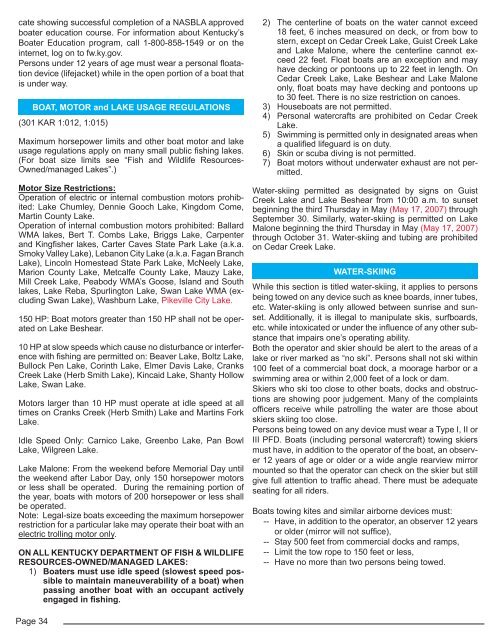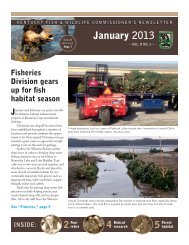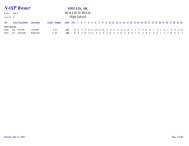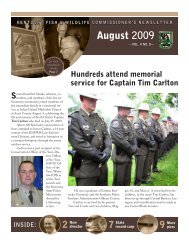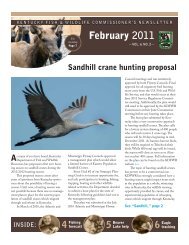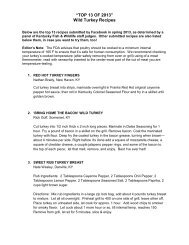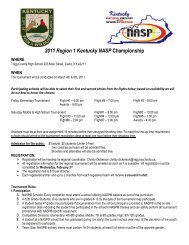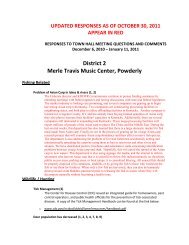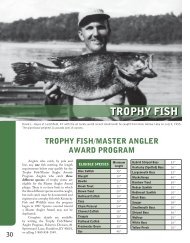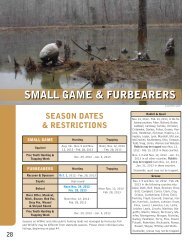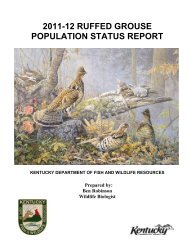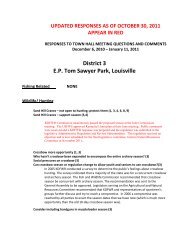2007 Sport Fishing and Boating Guide - Section 3 - Kentucky ...
2007 Sport Fishing and Boating Guide - Section 3 - Kentucky ...
2007 Sport Fishing and Boating Guide - Section 3 - Kentucky ...
You also want an ePaper? Increase the reach of your titles
YUMPU automatically turns print PDFs into web optimized ePapers that Google loves.
cate showing successful completion of a NASBLA approved<br />
boater education course. For information about <strong>Kentucky</strong>’s<br />
Boater Education program, call 1-800-858-1549 or on the<br />
internet, log on to fw.ky.gov.<br />
Persons under 12 years of age must wear a personal floatation<br />
device (lifejacket) while in the open portion of a boat that<br />
is under way.<br />
(301 KAR 1:012, 1:015)<br />
Maximum horsepower limits <strong>and</strong> other boat motor <strong>and</strong> lake<br />
usage regulations apply on many small public fishing lakes.<br />
(For boat size limits see “Fish <strong>and</strong> Wildlife Resources-<br />
Owned/managed Lakes”.)<br />
Motor Size Restrictions:<br />
Operation of electric or internal combustion motors prohibited:<br />
Lake Chumley, Dennie Gooch Lake, Kingdom Come,<br />
Martin County Lake.<br />
Operation of internal combustion motors prohibited: Ballard<br />
WMA lakes, Bert T. Combs Lake, Briggs Lake, Carpenter<br />
<strong>and</strong> Kingfisher lakes, Carter Caves State Park Lake (a.k.a.<br />
Smoky Valley Lake), Lebanon City Lake (a.k.a. Fagan Branch<br />
Lake), Lincoln Homestead State Park Lake, McNeely Lake,<br />
Marion County Lake, Metcalfe County Lake, Mauzy Lake,<br />
Mill Creek Lake, Peabody WMA’s Goose, Isl<strong>and</strong> <strong>and</strong> South<br />
lakes, Lake Reba, Spurlington Lake, Swan Lake WMA (excluding<br />
Swan Lake), Washburn Lake, Pikeville City Lake.<br />
150 HP: Boat motors greater than 150 HP shall not be operated<br />
on Lake Beshear.<br />
10 HP at slow speeds which cause no disturbance or interference<br />
with fishing are permitted on: Beaver Lake, Boltz Lake,<br />
Bullock Pen Lake, Corinth Lake, Elmer Davis Lake, Cranks<br />
Creek Lake (Herb Smith Lake), Kincaid Lake, Shanty Hollow<br />
Lake, Swan Lake.<br />
Motors larger than 10 HP must operate at idle speed at all<br />
times on Cranks Creek (Herb Smith) Lake <strong>and</strong> Martins Fork<br />
Lake.<br />
Idle Speed Only: Carnico Lake, Greenbo Lake, Pan Bowl<br />
Lake, Wilgreen Lake.<br />
Lake Malone: From the weekend before Memorial Day until<br />
the weekend after Labor Day, only 150 horsepower motors<br />
or less shall be operated. During the remaining portion of<br />
the year, boats with motors of 200 horsepower or less shall<br />
be operated.<br />
Note: Legal-size boats exceeding the maximum horsepower<br />
restriction for a particular lake may operate their boat with an<br />
electric trolling motor only.<br />
ON ALL KENTUCKY DEPARTMENT OF FISH & WILDLIFE<br />
RESOURCES-OWNED/MANAGED LAKES:<br />
1) Boaters must use idle speed (slowest speed possible<br />
to maintain maneuverability of a boat) when<br />
passing another boat with an occupant actively<br />
engaged in fishing.<br />
Page 34<br />
BOAT, MOTOR <strong>and</strong> LAKE USAGE REGULATIONS<br />
2) The centerline of boats on the water cannot exceed<br />
18 feet, 6 inches measured on deck, or from bow to<br />
stern, except on Cedar Creek Lake, Guist Creek Lake<br />
<strong>and</strong> Lake Malone, where the centerline cannot exceed<br />
22 feet. Float boats are an exception <strong>and</strong> may<br />
have decking or pontoons up to 22 feet in length. On<br />
Cedar Creek Lake, Lake Beshear <strong>and</strong> Lake Malone<br />
only, float boats may have decking <strong>and</strong> pontoons up<br />
to 30 feet. There is no size restriction on canoes.<br />
3) Houseboats are not permitted.<br />
4) Personal watercrafts are prohibited on Cedar Creek<br />
Lake.<br />
5) Swimming is permitted only in designated areas when<br />
a qualified lifeguard is on duty.<br />
6) Skin or scuba diving is not permitted.<br />
7) Boat motors without underwater exhaust are not permitted.<br />
Water-skiing permitted as designated by signs on Guist<br />
Creek Lake <strong>and</strong> Lake Beshear from 10:00 a.m. to sunset<br />
beginning the third Thursday in May (May 17, <strong>2007</strong>) through<br />
September 30. Similarly, water-skiing is permitted on Lake<br />
Malone beginning the third Thursday in May (May 17, <strong>2007</strong>)<br />
through October 31. Water-skiing <strong>and</strong> tubing are prohibited<br />
on Cedar Creek Lake.<br />
WATER-SKIING<br />
While this section is titled water-skiing, it applies to persons<br />
being towed on any device such as knee boards, inner tubes,<br />
etc. Water-skiing is only allowed between sunrise <strong>and</strong> sunset.<br />
Additionally, it is illegal to manipulate skis, surfboards,<br />
etc. while intoxicated or under the influence of any other substance<br />
that impairs one’s operating ability.<br />
Both the operator <strong>and</strong> skier should be alert to the areas of a<br />
lake or river marked as “no ski”. Persons shall not ski within<br />
100 feet of a commercial boat dock, a moorage harbor or a<br />
swimming area or within 2,000 feet of a lock or dam.<br />
Skiers who ski too close to other boats, docks <strong>and</strong> obstructions<br />
are showing poor judgement. Many of the complaints<br />
officers receive while patrolling the water are those about<br />
skiers skiing too close.<br />
Persons being towed on any device must wear a Type I, II or<br />
III PFD. Boats (including personal watercraft) towing skiers<br />
must have, in addition to the operator of the boat, an observer<br />
12 years of age or older or a wide angle rearview mirror<br />
mounted so that the operator can check on the skier but still<br />
give full attention to traffic ahead. There must be adequate<br />
seating for all riders.<br />
Boats towing kites <strong>and</strong> similar airborne devices must:<br />
-- Have, in addition to the operator, an observer 12 years<br />
or older (mirror will not suffice),<br />
-- Stay 500 feet from commercial docks <strong>and</strong> ramps,<br />
-- Limit the tow rope to 150 feet or less,<br />
-- Have no more than two persons being towed.
PERSONAL WATERCRAFT<br />
The term “personal watercraft” (PWC) means a vessel which<br />
uses an internal combustion engine to power a jet pump for<br />
its primary source of propulsion <strong>and</strong> is designed to be operated<br />
by a person sitting, st<strong>and</strong>ing or kneeling on the vessel<br />
rather than by a person sitting or st<strong>and</strong>ing inside the vessel.<br />
In addition to being governed by the same laws that apply to<br />
all boats, the following laws apply to personal watercraft:<br />
-- Personal watercraft can only be operated between<br />
sunrise <strong>and</strong> sunset.<br />
-- Personal watercraft without self-circling capability<br />
must have a lanyard-type engine kill switch attached<br />
to the operator when the craft is underway.<br />
-- Operators <strong>and</strong> passengers must wear a U.S. Coast<br />
Guard-approved personal fl otation device (PFD.)<br />
Because of their small size <strong>and</strong> low profi le, operators of<br />
PWCs should exercise defensive driving. These craft are<br />
highly responsive <strong>and</strong> capable of quick turns. In fact, this is<br />
part of the fun of their operation. However, this kind of operation<br />
is reckless if done in congested areas of boat traffi c.<br />
SMALL CRAFT PRECAUTIONS<br />
Statistics show that approximately half the boat-related fatalities<br />
involve boats that are less than 16’ in length. These<br />
boats are usually unstable <strong>and</strong> can tip over, throwing the<br />
occupants overboard. Also, these boats can be easily<br />
swamped, especially if used on a large body of water where<br />
the wind can cause high waves. When using such craft, be<br />
aware of the hazards. Wearing a personal fl oatation device<br />
(PFD) is strongly recommended.<br />
RECKLESS OPERATION<br />
The operator of a watercraft is responsible for damage caused<br />
by negligent operation. The following actions are considered<br />
reckless operation <strong>and</strong> are therefore against the law:<br />
-- weaving through traffi c;<br />
-- following watercraft too closely that is towing an individual<br />
on waterskis, a surfboard or any water sport device;<br />
-- jumping the wake of another craft in a way that endangers<br />
human life, physical safety or property;<br />
-- cutting between a boat <strong>and</strong> the individual(s) being<br />
towed by the boat;<br />
-- crossing the path of another boat when visibility is obstructed;<br />
-- steering toward an object or individual in the water <strong>and</strong><br />
turning sharply at close range.<br />
Persons shall not operate a motorboat or personal watercraft<br />
within 50 feet of a commercial vessel <strong>and</strong> its tow that is in<br />
operation on a waterway, except if the operator of the commercial<br />
vessel has given consent.<br />
When operating in a busy area, reduce speed <strong>and</strong> allow<br />
plenty of room for avoidance maneuvers. Even in areas that<br />
are not marked as idle speed, excessive wake can still be<br />
dangerous. Operators of larger craft should be aware of the<br />
wake their vessels are throwing.<br />
IDLE SPEED<br />
<strong>Kentucky</strong> law defi nes idle speed as the “slowest speed<br />
possible to maintain maneuverability” of a boat. Generally<br />
speaking for a properly adjusted boat, this is the speed when<br />
a boat is put into gear without advancing the throttle. Wakes<br />
can capsize small boats or cause damage to boats moored<br />
at marinas <strong>and</strong> docks. It is extremely important that boat operators<br />
be aware of their speed <strong>and</strong> the resulting wake. Operators<br />
are liable for any injuries or damage caused by their<br />
boat’s wake.<br />
Boaters may see buoys or signs that say “No Wake”. This<br />
means that boats must be at idle speed.<br />
LOCKS AND DAMS<br />
Boaters in <strong>Kentucky</strong> may encounter lock <strong>and</strong> dam systems.<br />
Generally, these will be on the Green, Ohio <strong>and</strong> <strong>Kentucky</strong><br />
Rivers (for the fi rst four locks upstream to Frankfort, KY), but<br />
a few impoundments have a lock <strong>and</strong> dam. Locks are a relatively<br />
simple method of raising or lowering boats from one<br />
water level to another. If lockage is desired, boaters should<br />
signal the lock operator by using the pull chain on each end<br />
of the lock or call on marine channel 13. If the lock is not immediately<br />
available, boaters should position their vessels a<br />
safe distance from the approach channel to avoid personal<br />
injury or damage to their boat from wakes caused by commercial<br />
tows entering or leaving the locks. Never moor a<br />
vessel in the lock approach channels.<br />
Dams associated with the locks can be very dangerous.<br />
Boaters should be alert for these structures. Dams are either<br />
conventional or “low head” type. Conventional dams are easily<br />
recognizable with their spillways <strong>and</strong> power installations.<br />
Low Head Dams are Dangerous<br />
Low head dams are usually marked with “keep out” buoys<br />
or “danger” signs above <strong>and</strong> below. Low head dams pose<br />
an even greater danger due to the fact that they are not as<br />
recognizable, especially when water is fl owing over them. It<br />
is this fl ow of water over the dam that creates a “boil” on the<br />
lower side. Boaters risk almost certain death if caught in this<br />
turbulence.<br />
BOIL<br />
LOW HEAD<br />
DAM<br />
Page 35
RESTRICTED ZONES<br />
(KAR 6:030)<br />
<strong>Kentucky</strong> law prohibits boats from operating within restricted<br />
areas as posted above or below navigation, power generating<br />
or flood control dams.<br />
No fish is worth risking your life. Be aware of trespassing<br />
<strong>and</strong> danger zones. Wear a PFD when entering any<br />
area above or below a dam.<br />
BUOYS<br />
Buoys are the most common types of navigational aid, <strong>and</strong><br />
they serve the same purpose as traffic signs on the highway.<br />
Failure to obey buoys can result in enforcement action, or<br />
worse, a loss of property or lives. When boating in unfamiliar<br />
waters, slow down <strong>and</strong> look for any regulatory or channelmarking<br />
buoys. Remember that it is possible for these buoys<br />
to drift out of position. <strong>Kentucky</strong> law prohibits from tying up to<br />
any buoy except designated mooring buoys.<br />
OPERATING UNDER THE INFLUENCE Riding on Decks or Gunwales<br />
(KRS 235.240)<br />
It is against the law to operate a boat or vessel including personal<br />
watercraft, manipulate water skis, surfboard or other<br />
similar device while intoxicated or under the influence of any<br />
other substance that impairs one’s driving ability. Any person<br />
who operates a vessel on <strong>Kentucky</strong> waters is considered to<br />
have given consent to a test or tests to determine his alcohol<br />
concentration or the presence of other drugs. The tests shall<br />
be administered at the direction of a law enforcement officer<br />
who has probable cause to believe that the operator is intoxicated.<br />
An operator refusing the test shall be in violation of the<br />
law <strong>and</strong> subject to the same penalties.<br />
Anyone who operates a boat, PWC, skis, surfboard or similar<br />
device while intoxicated with a blood alcohol level of 0.08<br />
or higher or while under the influence of any substance that<br />
impairs the operator’s driving ability may be subject to fines<br />
<strong>and</strong> possible jail time if convicted.<br />
BLOOD ALCOHOL CONTENT CHART<br />
Body Weight Number of Drinks in a Two Hour Period<br />
in Pounds 12 oz. beer=5 oz.wine=1 oz. 80 proof liquor<br />
100 1 2 3 4 5 6 7 8 9<br />
120 1 2 3 4 5 6 7 8 9<br />
140 1 2 3 4 5 6 7 8 9<br />
160 1 2 3 4 5 6 7 8 9<br />
180 1 2 3 4 5 6 7 8 9<br />
200 1 2 3 4 5 6 7 8 9<br />
220 1 2 3 4 5 6 7 8 9<br />
240 1 2 3 4 5 6 7 8 9<br />
BAC to .05% Be Careful- Loss of judgment <strong>and</strong> coordination<br />
BAC .05% Abilities Impaired- Chance of accident increased<br />
to .07%<br />
BAC .08% Do Not Operate a Boat- High risk of accident,<br />
<strong>and</strong> over subject to arrest.<br />
Page 36<br />
Drinking in Public <strong>and</strong> Public Intoxication (KRS 222.202)<br />
<strong>Kentucky</strong> law specifically prohibits the drinking of alcoholic<br />
beverages in public places (this excludes establishments licensed<br />
to sell such beverages) <strong>and</strong> the waterways of this<br />
state are considered public places.<br />
Further, in a public place, persons who are manifestly under<br />
the influence of alcoholic beverages to the extent that they<br />
may unreasonably annoy or endanger themselves or others<br />
shall be subject to arrest.<br />
Prohibited Riding<br />
Approximately half of boat related fatalities result from falls<br />
overboard. When operating a motorboat above idle speed<br />
the operator or passengers shall not ride on an enclosed<br />
bow, outside protective railing of a pontoon or houseboat,<br />
on a seat which extends six inches above the plane of the<br />
gunwales, nor shall they ride on the sides, back, engine cover,<br />
back of seat, or any other obviously dangerous position<br />
which could lead to falling overboard.<br />
Persons should ride only in the<br />
areas designated for such.<br />
RULES OF THE ROAD<br />
On the water there are no painted lines to mark where boats<br />
must go. In order to provide an orderly flow of traffic, there<br />
are “rules of the road” that boaters should learn <strong>and</strong> practice.<br />
Boaters on the water encounter three situations: meeting,<br />
crossing <strong>and</strong> overtaking. The following diagrams should give<br />
a clear explanation of who has the right of way (st<strong>and</strong>-on<br />
vessel) <strong>and</strong> who must give way (give-way vessel). However,<br />
in an emergency, all vessels must give way to avoid a collision.<br />
At night, a boat’s navigation lights give an indication<br />
of right of way (see section titled “Navigation Lights” in this<br />
guide).<br />
The above rules cover most traffic situations, but a few other<br />
situations exist. Sailboats under sail have the right of way<br />
except when they are the overtaking vessel. Rowboats <strong>and</strong><br />
paddle powered boats have the right of way over motorboats.<br />
All recreational craft should yield the right of way to large<br />
commercial craft (towboats, barges). Such vessels have<br />
large blind spots <strong>and</strong> will be unable to see smaller crafts in<br />
front of them.<br />
On small or narrow bodies of water, all traffic should stay to<br />
the right of mid-channel <strong>and</strong> not “cut corners”.
Meeting Situation<br />
Crossing Situation<br />
Give-way<br />
Vessel<br />
Overtaking Situation<br />
Give-way Vessel<br />
Overtaking<br />
Danger Zone<br />
112 o<br />
REQUIRED EQUIPMENT<br />
St<strong>and</strong>-on Vessel<br />
holds course <strong>and</strong> speed<br />
St<strong>and</strong>-on Vessel<br />
being overtaken<br />
(301 KAR 6:020)<br />
For each person onboard a vessel, federal as well as state<br />
law requires a Type I, II, or III personal fl otation device (PFD)<br />
on all boats. Boats 16 feet <strong>and</strong> over, except canoes <strong>and</strong> kayaks,<br />
must also carry one Type IV throwable PFD. Operators<br />
<strong>and</strong> passengers of personal watercraft must wear a PFD.<br />
Persons under 12 years of age must wear a personal fl oatation<br />
device, or life jacket, while in the open part of a boat<br />
while it is under way.<br />
Personal Flotation Devices<br />
The <strong>Kentucky</strong> Department of Fish <strong>and</strong> Wildlife Resources<br />
strongly recommends that PFDs be worn while boating, especially<br />
by children <strong>and</strong> nonswimmers. In order for PFDs to<br />
be legal, the following requirements must be met:<br />
-- Coast Guard approved: A label with an approval number<br />
will be on the PFD.<br />
-- Serviceability: All straps, buckles, zippers, stitching,<br />
must be intact <strong>and</strong> the fabric should not be rotted.<br />
Some PFDs contain airtight bags fi lled with a fi brous<br />
material. Squeeze the bags. If air escapes destroy the<br />
PFD <strong>and</strong> replace it with a new one.<br />
-- Size: PFDs must fi t the people they are intended for.<br />
Read the label to determine size <strong>and</strong> weight restrictions.<br />
-- Accessibility: PFDs must be readily available for immediate<br />
use by all occupants of a vessel. It is advisable<br />
for each person to try on their PFD before departing so<br />
that they are familiar with the fastening devices <strong>and</strong> to<br />
assure it is adjusted to the person. PFDs shouldn’t be<br />
stored in the plastic bags they were sold in. This limits<br />
access <strong>and</strong> can promote rotting of the device.<br />
TYPE 1 <strong>and</strong> TYPE 2:<br />
These devices are designed, when worn properly, to turn a<br />
person who is unconscious <strong>and</strong> face down in the water to a<br />
vertical or slightly backward face up position.<br />
TYPE 1 TYPE 2<br />
TYPE 4<br />
These PFDs are designed<br />
to be thrown<br />
to persons in the<br />
water who can hold<br />
on to them until help<br />
arrives. They are not<br />
designed to be worn,<br />
<strong>and</strong> could cause<br />
drowning if worn on<br />
the back.<br />
TYPE 3<br />
These are special<br />
purpose devices that<br />
include ski vests, fi shing<br />
vests <strong>and</strong> fl oat<br />
coats. They are not<br />
designed to turn a<br />
person face out of<br />
the water, but they do<br />
have the same buoyancy<br />
as the type I <strong>and</strong><br />
II PFDs <strong>and</strong> are more<br />
comfortable to wear.<br />
Page 37
Fire Extinguishers<br />
<strong>Kentucky</strong> law requires that all boats equipped with a petroleum<br />
product (gasoline, kerosene, propane, etc.) consuming<br />
device (engines, lanterns, stoves, etc.) shall have a h<strong>and</strong><br />
portable fire extinguisher in serviceable condition <strong>and</strong> located<br />
for immediate use. The best fire protection is well maintained<br />
equipment <strong>and</strong> proper safety habits.<br />
MARINE FIRE EXTINGUISHER CLASSIFICATION<br />
MINIMUM NUMBER OF B-1 FIRE EXTINGUISHERS<br />
Vessel/Size Class A Class 1 Class 2 Class 3<br />
No Fixed Fire 1 1 2 3<br />
extinguisher system<br />
Fixed Fire 0 0 1 2<br />
extinguisher system<br />
Installed<br />
There are fuels other than gasoline that cause fires. Many<br />
houseboats use bottled gas (propane) for stoves <strong>and</strong> other<br />
appliances. Also, many fishermen will use a lantern while<br />
fishing at night; if tipped over it can cause a fire.<br />
Backfire Flame Arresters<br />
Internal combustion engines may backfire. To safeguard<br />
against fire, all motorboats with enclosed engines <strong>and</strong> engines<br />
originally equipped with a flame arrester, (except<br />
outboards <strong>and</strong> diesels) must have an approved carburetor<br />
backfire flame arrester system on each carburetor.<br />
Page 38<br />
Ventilation<br />
Most fires on a boat are due to ignition of fuel vapors. Gasoline<br />
is heavier than air. It can collect in the bilge or engine<br />
compartment <strong>and</strong> any spark can ignite it. Therefore, <strong>Kentucky</strong><br />
law requires boats to have adequate ventilation of areas<br />
where flammable vapors can accumulate.<br />
Most boats are equipped with adequate ventilation systems<br />
when they come from the factory. Usually, this is a combination<br />
of active <strong>and</strong> passive systems. Active systems use electrical<br />
blowers to exhaust flammable vapors from the bilge<br />
<strong>and</strong> other areas. Passive systems are ducts <strong>and</strong> cowls that<br />
ventilate areas when the boat is moving. Almost all inboards<br />
will have an electrical blower installed in the engine compartment.<br />
Operators should run the blower for several minutes<br />
before starting the engine. If the blower is inoperable it<br />
should be repaired or replaced immediately. Many boat fires<br />
take place after refueling, so care should be taken to avoid<br />
spilling fuel in the vessel.<br />
Navigation Lights<br />
All vessels when underway between sunset <strong>and</strong> sunrise<br />
must display proper navigation lights. Navigation lights on<br />
boats are restricted to the colors of red, green <strong>and</strong> white.<br />
-- Class A <strong>and</strong> Class 1 motorboats shall display lights as<br />
represented in figure 1.<br />
-- Class 2 <strong>and</strong> Class 3 motorboats shall display lights as<br />
represented in figure 2.<br />
-- Sailboats of class A <strong>and</strong> Class 1 shall display lights as<br />
represented in figure 3.<br />
-- Sailboats of Class 2 <strong>and</strong> Class 3 shall display lights as<br />
represented in figure 4.<br />
From sunset to sunrise in an area where other boats navigate,<br />
all vessels shall display a steady white light visible 360<br />
degrees at all times. Manually propelled vessels shall carry a<br />
white light to display in sufficient time to avoid a collision.<br />
The purpose of the red <strong>and</strong> green navigation lights at night<br />
is to show if your boat is in a meeting, crossing or overtaking<br />
situation. The red <strong>and</strong> green lights must be displayed from<br />
sunset to sunrise whenever a boat is underway. They will<br />
give some indication of the size <strong>and</strong> speed of vessels. The<br />
red <strong>and</strong> green bow lights are especially helpful in determining<br />
right of way in crossing situations. In the diagram below,<br />
boat B sees the green bow light of boat A, <strong>and</strong> has the right<br />
of way to continue on course. Boat A sees the red bow light<br />
of boat B <strong>and</strong> must stop or pass astern of boat B.<br />
LEAVE A NOTE<br />
When planning a boating trip, leave a note, or float<br />
plan, with someone to let them know where you are.<br />
Include your departure <strong>and</strong> expected return times, the<br />
waters where you will be boating, a description <strong>and</strong>/or<br />
license number of the vessel <strong>and</strong> where you can be<br />
reached in case of emergency
Signaling Devices<br />
<strong>Kentucky</strong> law states that all boats 16 feet in length or longer<br />
must have a h<strong>and</strong>-, mouth- or power-operated signaling device<br />
capable of producing a blast for two seconds or more<br />
<strong>and</strong> audible for one-half mile for class 1 vessels, one mile for<br />
class two vessels <strong>and</strong> one <strong>and</strong> one-half miles for class three<br />
vessels. This does not exempt vessels from any other signaling<br />
device as may be required by federal law when operating<br />
on navigable waters of this state.<br />
Maneuvering <strong>and</strong> Warning Signals<br />
ONE LONG BLAST: Warning signal (coming out of slip)<br />
ONE SHORT BLAST: Pass on my port side (left)<br />
TWO SHORT BLASTS: Pass on my starboard (right)<br />
THREE SHORT BLASTS: Engines in reverse<br />
FIVE OR MORE BLASTS: Danger signal<br />
Muffl ing Devices<br />
<strong>Kentucky</strong> law requires all boats to be equipped with effective<br />
exhaust muffl ing devices. Usually, boats <strong>and</strong> motors that<br />
come direct from the manufacturer are adequately muffl ed.<br />
However, there may be instances of high performance boats<br />
that have been modifi ed by the owners that are not in compliance<br />
with the law. Additionally, there may be federal <strong>and</strong>/or<br />
local regulations restricting boats with an over-the-transom<br />
exhaust system.<br />
Marine Sanitation Devices (KRS 235:420)<br />
Motorboats with marine toilets are not allowed on public waters<br />
unless the toilet is equipped with a Type I, II or III marine<br />
sanitation device (MSD.) Type I <strong>and</strong> II MSDs chemically treat<br />
sewage. Type III MSDs are holding tanks for raw sewage.<br />
Raw sewage shall not be discharged in any public waters.<br />
Treated sewage may be discharged from a marine toilet into<br />
legal “discharge” waters. Those waters are Barkley <strong>and</strong> <strong>Kentucky</strong><br />
lakes, Lake Cumberl<strong>and</strong>, Dale Hollow Lake <strong>and</strong> any of<br />
the major river systems. Type I <strong>and</strong> II MSDs must be sealed<br />
or locked while the vessel is on “no discharge” waters.<br />
Crossing Situation<br />
Maintain Course <strong>and</strong> Speed.<br />
BOAT A<br />
WHITE<br />
RED<br />
GREEN<br />
DANGER<br />
ZONE<br />
RED<br />
BOAT B<br />
WHITE<br />
WHITE<br />
WHITE<br />
GREEN<br />
WHITE<br />
GREEN<br />
FIGURE 4<br />
GREEN<br />
GREEN<br />
GREEN<br />
FIGURE 1<br />
RED<br />
FIGURE 2<br />
RED<br />
FIGURE 3<br />
RED<br />
RED<br />
Page 39
(301 KAR 6:030, KRS 235.250)<br />
Reporting Requirements<br />
If any of the following conditions occur as the result of a boating<br />
accident, collision, etc., a <strong>Boating</strong> Accident Report must<br />
be made:<br />
-- death or disappearance of a person;<br />
-- injury to a person which requires medical attention or<br />
incapacitates that person for 24 hours or more;<br />
-- loss or damage to property (including the vessel) in an<br />
amount of $500 or more.<br />
The operator of a vessel is required to complete the report. If<br />
the operator is not capable of filing the report <strong>and</strong> is not the<br />
owner of the vessel, then the owner shall be required to fill<br />
out a boating accident report.<br />
Note 1: Even if a Law Enforcement Officer fills out a boating<br />
accident report, this does not exempt the operator from filing<br />
a report.<br />
Note 2: The reports filed by operators of vessels are confidential<br />
<strong>and</strong> are not available as public record (KRS 235.250).<br />
However, reports made by officers are available for review.<br />
Accidents involving death or serious injury must be submitted<br />
to the Division of Law Enforcement within 48 hours. All<br />
others must be submitted within five days.<br />
A boating accident report form is included in this guide. Additional<br />
forms are available from wildlife <strong>and</strong> boating law enforcement<br />
officers or by writing to <strong>Kentucky</strong> Department of<br />
Fish <strong>and</strong> Wildlife Resources, Division of Law Enforcement,<br />
#1 <strong>Sport</strong>sman’s Lane, Frankfort, KY 40601, or by calling<br />
1-800-858-1549.<br />
Rendering Aid<br />
An operator of a vessel involved in a boating accident shall<br />
render aid to other persons <strong>and</strong> vessels as long as it doesn’t<br />
endanger his crew, passengers or vessel. Also, the operator<br />
of any vessel involved in an accident shall give his name,<br />
address, <strong>and</strong> identification of his vessel, in writing, to any<br />
person that is injured or to the owner of any property that is<br />
damaged.<br />
First Aid<br />
This section includes suggestions that may save a life. First,<br />
boats should be equipped with a first aid kit. This kit should<br />
be able to provide treatment for burns, insect bites, cuts <strong>and</strong><br />
abrasions.<br />
Second, boaters should take a first aid course so they know<br />
how to treat victims with sprains, broken bones <strong>and</strong> shock.<br />
Third, boaters should know how to perform Cardiopulmonary<br />
Resuscitation (CPR) in case they encounter victims of near<br />
drowning, heart attack or trauma from boating accidents. In<br />
many cases, emergency medical help is further away on the<br />
water than on l<strong>and</strong>. Interested persons should contact their<br />
local chapter of the American Red Cross for information on<br />
first aid <strong>and</strong> CPR training.<br />
Page 40<br />
ACCIDENTS<br />
Hypothermia<br />
Four elements cause hypothermia -- cold, moisture, wind <strong>and</strong><br />
exhaustion. Symptoms of hypothermia are uncontrollable<br />
shivering, slurred speech, stumbling, blue skin, decreased<br />
heart <strong>and</strong> breathing rate, weak pulse <strong>and</strong> unconsciousness.<br />
All hypothermia symptoms dem<strong>and</strong> immediate attention. As<br />
soon as possible, a victim of hypothermia should be brought<br />
out of the weather. Wet clothing should be replaced with dry<br />
clothing. If the victim shows mild symptoms, get them near<br />
a fire or other heat source or put them in a warm sleeping<br />
bag. For victims with advanced symptoms of hypothermia,<br />
seek immediate medical attention. Never give alcohol to the<br />
victim.<br />
The best cure for hypothermia is prevention. Monitor weather<br />
reports when you plan to be in the outdoors. Dress in layers<br />
<strong>and</strong> always have foul-weather gear h<strong>and</strong>y.<br />
OTHER SITUATIONS<br />
Skin <strong>and</strong> SCUBA Diving (301 KAR 1:040, 6:030)<br />
Skin or SCUBA diving is prohibited in all lakes owned by<br />
the <strong>Kentucky</strong> Department of Fish <strong>and</strong> Wildlife Resources,<br />
except during emergencies <strong>and</strong> during salvage operations<br />
when the diver has written permission from the regional director<br />
or local wildlife <strong>and</strong> boating law enforcement officer<br />
assigned to the specific body of water in which the diving is<br />
to take place.<br />
Persons diving or submerging with the aid of a mechanical<br />
breathing apparatus in an area where boats might be are<br />
required by law to display the diver’s flag.<br />
This flag should be put on a buoy, boat or other floating platform<br />
so boaters will readily see it. Approaching boats must<br />
stay outside of a 100-foot radius of the flag. Divers must surface<br />
within a 50-foot radius unless there is an emergency.<br />
Divers shall not dive in established traffic lanes nor interfere<br />
with anyone fishing unless emergency operations are<br />
in progress.<br />
Alpha FLAG - Blue with silver stripe, displayed<br />
on vessel with restricted mobility because of diving<br />
operation.<br />
Diver’s FLAG - Red flag at least 12” x 12”<br />
with diagonal stripe at least three inches wide,<br />
displayed where diver is submerged.
Swimming<br />
Swimming in any lake controlled <strong>and</strong>/or owned by the KD-<br />
FWR is prohibited except in areas specifically set aside for<br />
swimming at which a qualified lifeguard is on duty. <strong>Kentucky</strong><br />
law specifically prohibits swimming at any boat launching<br />
ramp. Swim in marked <strong>and</strong> supervised areas. If you are a<br />
nonswimmer or a poor swimmer, wear a PFD. Remember,<br />
PFDs are not just for boaters.<br />
Refrain from drinking alcoholic beverages when swimming.<br />
Alcohol greatly reduces a person’s reflexes <strong>and</strong> strength<br />
when in the water. For persons who have had alcoholic beverages<br />
a PFD is the difference between life <strong>and</strong> death.<br />
Persons who wish to swim a long distance should swim parallel<br />
to the shore instead of across a river or lake. Boaters<br />
don’t normally expect to see swimmers in the middle of a<br />
lake or river <strong>and</strong> may run over them.<br />
Inflatables<br />
Air mattresses, inner tubes <strong>and</strong> other similar devices are<br />
generally used as recreational items by persons swimming<br />
or sunbathing. Use of these items should be restricted to<br />
designated or generally recognized swimming areas <strong>and</strong><br />
not be used in areas of boat traffic. Nonswimmers or poor<br />
swimmers should not depend on these devices to save their<br />
life. These items can be punctured <strong>and</strong> lose their buoyancy<br />
- wear a PFD!<br />
Fatigue<br />
Boaters should be aware of the factors that induce fatigue<br />
while on the water. The wind, sun, engine noise <strong>and</strong> constant<br />
motion of the boat can greatly reduce a person’s reaction<br />
time.<br />
Littering<br />
(KRS 433.757)<br />
The operator of any motorboat or vessel is responsible for<br />
any litter thrown into the water. Litter is not only unsightly, but<br />
can be dangerous to humans <strong>and</strong> animals. For example,<br />
fishing line discarded into the water can be hazardous to<br />
wildlife <strong>and</strong> to a boat’s lower unit. Animals can be ensnared<br />
in the line <strong>and</strong> die. <strong>Fishing</strong> line caught on a prop shaft can<br />
cause seal leaks <strong>and</strong> lower unit failure. Trot lines <strong>and</strong> limb<br />
lines can snare animals <strong>and</strong> other anglers in boats.<br />
<br />
<br />
Page 41
Page 42<br />
UNIFORM STATE WATERWAY<br />
MARKING SYSTEM
Page 43
Page 44


